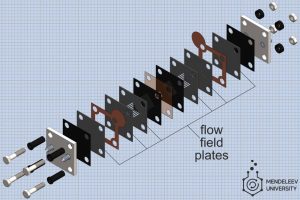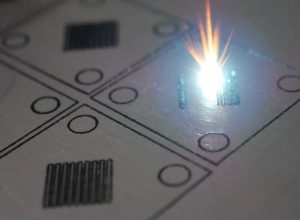Flow batteries are energy storing structures that store chemical energy as liquid electrolytes in tanks, and pump those liquids to a reaction site – a membrane-electrode assembly (MEA) – when electricity must be produced or re-charge is needed.
This separates the number of watts a flow battery can produce from the number of joules it can store – bigger tanks give more joules, or a bigger MEA gives more watts. As such, flow batteries are one possible technology for future grid-scale energy storage – storage that is increasingly needed on energy grids as the proportion of solar and wind derived energy is increased.
Vanadium redox type flow batteries particularly attractive for grid storage because the electrolytes do not degrade, even after tens of thousands of operating cycles.
Now scientists from Mendeleev University of Chemical Technology in Russia are proposing a new design of MEA for vanadium redox flow batteries, using flow plates made from laser-cut graphite foil.
 “We have proposed a completely new design of MEA, which will facilitate the research process and greatly reduce entrance threshold for new research groups into this area,” said Dmitry Konev, a scientist at ‘IPCP RAS’, an institute working with the university on this project. “This will help to achieve significant progress and will bring distributed energy resources from niche positioning to very high level of commercialisation.”
“We have proposed a completely new design of MEA, which will facilitate the research process and greatly reduce entrance threshold for new research groups into this area,” said Dmitry Konev, a scientist at ‘IPCP RAS’, an institute working with the university on this project. “This will help to achieve significant progress and will bring distributed energy resources from niche positioning to very high level of commercialisation.”
MEAs are sandwich structures where electrons are produced or consumed when one of the electrolytes is oxidised and the other is reduced – hence ‘redox’.
The way that these electrolytes flow through the sandwhich is controlled by flow plates (see diagram).
“The performance of the battery depend strongly on how well the flow fields are organised,” according to the university. “Therefore, researchers often select different types of fields to optimise battery performance, but this is labour-intensive task” – as flow fields are milled into graphite plates.
 Instead, the Russian researchers have proposed a different approach.
Instead, the Russian researchers have proposed a different approach.
“We form flow fields by using several thin layers of flexible graphite materials – the necessary patterns in them are cut by a laser and then these layers are superimposed on each other to get the required field”, said Mendeleev Univeristy researcher Roman Pichugov. “The procedure to create flow fields takes only a few minutes, which is much less than traditional milling of graphite. Plus, cheaper materials are used, and as a result, there is more scope for variation and selection of flow fields.”
Using the laser-cut flow-plates, the Russian team tested various vanadium salts solution flow fields and “obtained results that on a qualitative level coincide with the best world studies and on a quantitative level even slightly surpass them: the power of the tested MEA slightly exceeded the power of similar cells on graphite,” said the university. “Thus, the new design of MEA is greatly simplifying laboratory test and in the future can be used in real energy storage systems for distributed power grids.”
With vanadium‐sulphuric acid electrolyte, the graphite sheet MEA cell demonstrated 734mW/cm2 peak power density at SOC 50 and 84.3 % of energy efficiency at 84.5 % of electrolyte utilisation under galvanostatic charge/discharge cycling with 75mA/cm2, according to ‘Electrolyte flow field variation: A cell for testing and optimization of membrane electrode assembly for vanadium redox flow batteries‘, whihc describes the work in ChemPlusChem.
www.electronicsweekly.com

